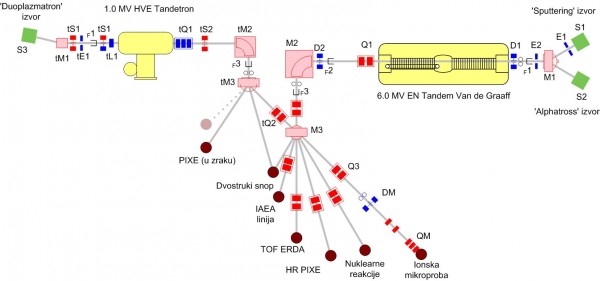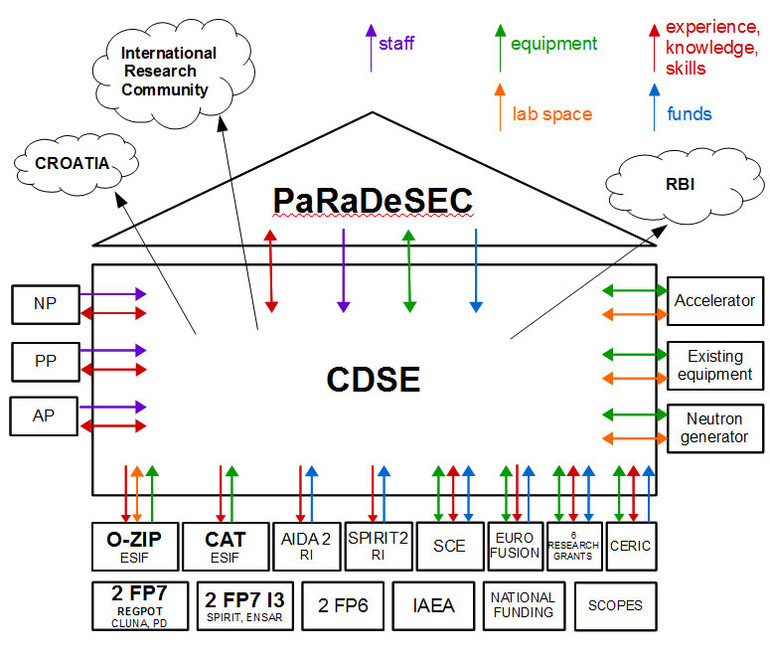About RBI
CDSE Foundation
Project Activities
Linked Activities
Expected Impact
Workplan
Management
News Archive
Popularization of Science
CDSE foundation: The Detector, Sensor, and Electronics groups capabilities
A very significant component of O-ZIP, and RBI in general, involves the nuclear, particle and astroparticle physics groups of RBI, in particular their involvement in detectors, sensors, and electronics. They comprise more than 50 scientists, and are in many ways the most propulsive and successful component of RBI, including a disproportionately high number of publications and citations.
CDSE is in fact based on the resources and activities of these researchers.
This includes a large number of competitive international projects from FP6/7, IAEA, NATO and many other sources. Such projects, among other, enabled the formation of a very significant research infrastructure. Examples include the recently completed two major FP7 REGPOT projects, worth a total of more than 1.5 million Euros – “Particle Detectors” and “Clustering phenomena in nuclear physics: strengthening of the Zagreb-Catania-Birmingham partnership”.
In particular, a key foundation of CDSE is “Particle Detectors” and its impact on RBI. The “Particle Detectors” project significantly contributed to RBI’s research potential for detector testing and development in particle and nuclear physics and applications. Collaboration with seven prominent European research entities has been initiated and strengthened. Six researchers were employed, of which two remained in Croatia after the project closure (one at the University of Zagreb and one at RBI). The equipment pool was upgraded with detectors, diagnostic tools and development of detector testing chamber at the local accelerator centre. With the success of the project, interest increased among other research groups for detector development and testing, including radiation detection and sensors in other related fields. As a result of this increased interest and capacity for detector related work, RBI became involved as a partner in several collaborative EU projects, such as the large infrastructure project AIDA-2 and Eurofusion project.
The legacy of the “Particle Detectors” project spreads much wider: its members initiated key structural changes at RBI, started the ESIF O-ZIP project proposal, listed now as major national project in the Croatian Operational Program Competitiveness and Cohesion 2014 – 2020, and originated the present project proposal.
A key focus of the activities is based on the local accelerator centre, the largest experimental complex in Croatia. The centre is in many ways a world-class facility, and is the only research facility in Croatia providing trans-national access to international users, through the FP7 I3 project SPIRIT and H2020 AIDA2. It has many state of the art components, with most of them built, developed, or maintained by the local staff.

Another area of focus is work at top international projects, such as experiments at CERN, Geneva. In many of these collaborations RBI researchers have been involved in the design, creation, or testing of different novel detector and sensor systems and associated front-end and data acquisition electronics and control systems. There are in fact numerous cases of successful international collaborative activities, with either high potential for industrial applications, or actual commercial deployment.

Fig. 1.1 Schematic presentation of the PaRaDeSEC project including relations with other executed (bottom line), expected (2 ESIF, H2020 RI,) and current (AIDA RI, Scientific Centre of excellence, H2020 Eurofusion, CERIC-ERIC, 6 research grants) projects. Staff of the research groups (left side, NP: nuclear physics PP: particle physics AP: astroparticle physics) and existing research infrastructure (right side) are contributing to the project execution.